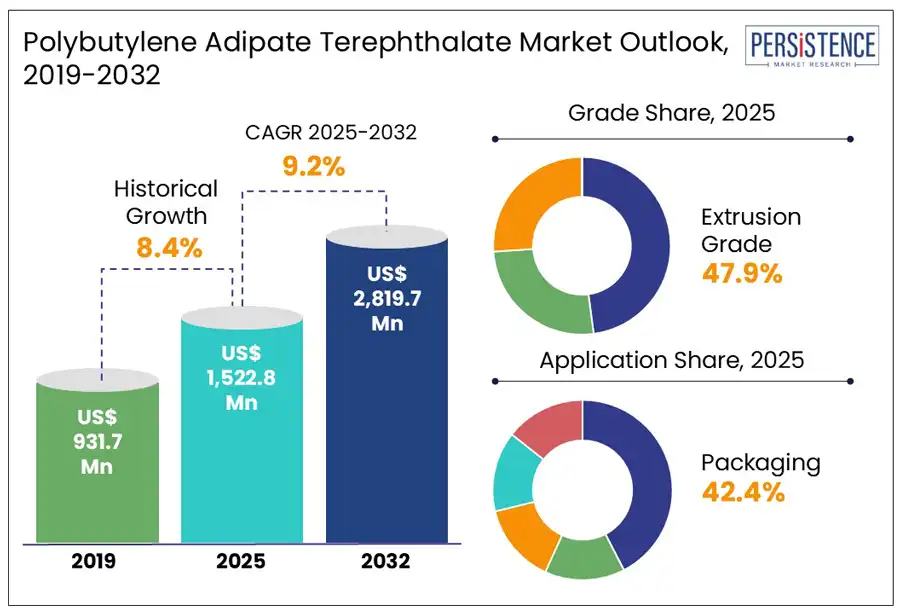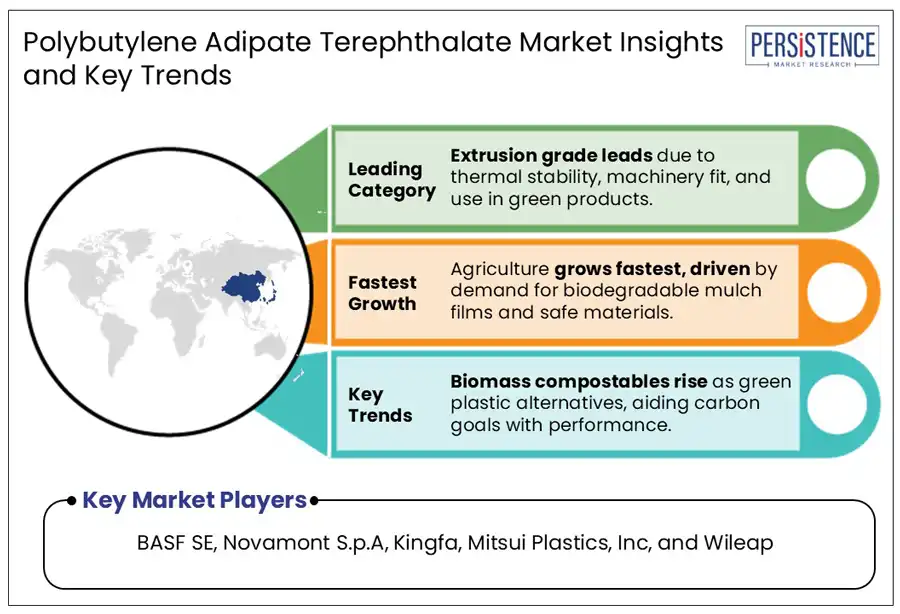Comprehensive Snapshot for Polybutylene Adipate Terephthalate Market Research Report, Including Regional and Country Analysis in Brief.
Industry: Chemicals and Materials
Published Date: April-2025
Format: PPT*, PDF, EXCEL
Delivery Timelines: Contact Sales
Number of Pages: 190
Report ID: PMRREP35233
According to the Persistence Market Research report, the global polybutylene adipate terephthalate market size is poised to reach US$ 1,522.8 Mn by 2025. With intensifying demand for compostable alternatives to conventional plastics, the market is set to grow at a CAGR of 9.2%, achieving a valuation of US$ 2,819.7 Mn by 2032. Growing concerns over plastic pollution and landfill overflow have pushed industries and regulators toward scalable biodegradable solutions, positioning polybutylene adipate terephthalate as a preferred material.
The industry is poised to benefit from rapid expansion in the bioplastics segment, where global production capacity is projected to increase from 2.47 million tonnes in 2024 to around 5.73 million tonnes by 2029. Although bioplastics currently represent only 0.5% of the nearly 414 million tonnes of total plastics produced each year, strong innovation and policy support encourages exponential growth. Applications now span across packaging, agriculture, and consumer products, opening up new opportunities for bio-based polymers to replace fossil-based materials.
As industries pursue net-zero goals, demand for biodegradable compounds continues to outpace legacy plastic materials. With governments enforcing bans on single-use plastics and consumers favoring sustainable alternatives, PBAT-based solutions find solid ground in global markets. Innovations in raw material sourcing and compostability certifications further enhance its commercial appeal, making it an indispensable contributor to the evolving circular economy.

Key Industry Highlights:
|
Market Attribute |
Key Insights |
|
Polybutylene Adipate Terephthalate Market Size (2024A) |
US$ 1,394.5 Million |
|
Estimated Market Size (2025E) |
US$ 1,522.8 Million |
|
Projected Market Value (2032F) |
US$ 2,819.7 Million |
|
Value CAGR (2025 to 2032) |
9.2% |
|
Historical Market Growth (CAGR 2019 to 2024) |
8.4% |
Sustainability-focused innovation continues to reshape global material preferences, especially in industries seeking compostable, low-carbon alternatives to conventional plastics. Biomass-balanced solutions offer a distinct advantage, replacing fossil feedstocks with renewable waste-derived inputs while maintaining functional and certification parity. This evolution supports companies aiming to decarbonize supply chains without altering performance parameters.
BASF SE’s introduction of ecoflex® F Blend C1200 BMB on June 7, 2024, marks a breakthrough in this domain. The newly launched PBAT-based grade carries a 60% lower product carbon footprint, enabling packaging producers to meet emissions goals while maintaining compliance with EN 13432 and other compostability standards.
A significant challenge in achieving full sustainability within the Polybutylene Adipate Terephthalate market lies in the limited substitution of fossil-based inputs. Despite advancements in renewable feedstock, the current production process still depends on petrochemical derivatives to meet cost and performance requirements. Although solutions such as biomass-balanced approaches have reduced fossil inputs, they cannot entirely replace them.
Manufacturers continue to rely on conventional sources to ensure that the final product meets critical characteristics, such as strength, durability, and processing efficiency. This ongoing dependency slows the transition to fully sustainable alternatives.
The reliance on fossil-based inputs also presents a challenge when companies try to market their products as fully green or sustainable. While certification systems and mass-balance models help address these concerns by offering a path for renewable content attribution, achieving true transparency in the supply chain remains complex. For instance, the traceability of the renewable materials through the entire production process cannot be precisely affirmed. This lack of clarity and consistency limits the broader adoption of fully bio-based bioplastics by manufacturers aiming to meet increasingly stringent sustainability regulations and consumer expectations for fossil-free alternatives.
Process streamlining and raw material optimization have opened up significant commercial opportunities across the polybutylene adipate terephthalate manufacturing ecosystem. Companies now focus on upstream enhancements to improve yield, selectivity, and sustainability in the sourcing of base materials. Innovations in catalyst design have proven critical in reducing operational inefficiencies and strengthening cost positions for downstream biopolymer producers.
BASF’s launch of the O4-204 catalyst in September 2021, designed specifically for improving maleic anhydride production, demonstrates this shift. As a foundational chemical in the value chain, maleic anhydride benefits from enhanced conversion rates and longer catalyst life under this new solution. This advancement helps reduce input costs and increase overall feedstock efficiency. The resulting cost-effectiveness enhances the competitiveness of compostable bioplastics, allowing broader adoption across geographies and industries. By integrating catalytic innovations into feedstock pathways, producers unlock economic scale and reinforce the long-term growth potential of sustainable polymer alternatives.
Extrusion grade held 47.9% market share in 2024, emerging as the top-performing category by grade. This grade benefits from excellent thermal stability, consistent flow properties, and compatibility with existing extrusion machinery.
Manufacturers rely on extrusion grades to produce high-quality films and sheets used across sustainable applications, including mulch films, compostable liners, and thermoformed trays. Demand for bio-based and compostable extrusion products continues to rise due to regulatory shifts and corporate sustainability mandates. The segment’s growth aligns directly with increasing investments in compostable packaging formats and a growing preference for drop-in materials in industrial processing lines.
Packaging is expected to account for a 42.4% market share in 2025, establishing itself as the leading application type amid accelerating demand for sustainable solutions. Industry players prefer this material for its proven biodegradability, superior sealing ability, and safe interaction with food products.
Companies across food service, agriculture, and retail continue to expand usage in both rigid and flexible packaging formats. Indian policymakers have enforced stricter environmental standards, which further stimulates demand in this category. Packaging companies actively shift toward compostable materials to meet regulatory benchmarks and address the growing consumer preference for eco-friendly alternatives.

East Asia is anticipated to hold a substantial 39.8% share in 2025, led by China's industrial capacity, strong domestic consumption, and regulatory measures targeting single-use plastics. Asian countries are known as production hubs for polybutylene adipate terephthalate, supported by continuous capacity expansion and strategic government initiatives promoting biodegradable alternatives.
In 2022, global biodegradable plastic production stood at approximately 1.14 million tonnes, with PBAT accounting for the largest share. A significant portion of this output is sourced from East Asia. By 2027, PBAT production is projected to reach over 3.5 million tonnes, reinforcing the region’s role in global supply chains.
East Asia’s policy direction supports the development of a circular bioeconomy, encouraging sustainable resource use and aligning with China's broader green development agenda. The bioplastics sector, while still emerging, shows strong potential across packaging and related applications. The trend reflects increasing investment in compostable materials, positioning PBAT as a central component in Asia's transition toward environmentally responsible packaging solutions.
Europe is expected to account for a market share 21.5% supported by EU regulations that restrict non-compostable plastics, widespread adoption of sustainable packaging, and advanced waste management infrastructure. The region plays a pivotal role in both innovation and demand generation within the bioplastics sector.
Global biodegradable plastics capacity is projected to increase from 2.2 million tonnes in 2022 to 6.3 million tonnes by 2027, with Europe contributing significantly through early-stage R&D and deployment of advanced materials. PBAT continues to gain traction alongside bioplastics such as PLA and PBS.
The European Union actively funds the transition toward a circular, low-carbon economy, encouraging the use of compostable materials and renewable feedstocks. This policy environment positions Europe as a strategic market for PBAT applications, particularly in the packaging and consumer goods sectors seeking compliance and sustainability. The region’s role remains central to advancing the global adoption of bioplastics over the coming years.
The global polybutylene adipate terephthalate market exhibits a moderately consolidated structure, driven by a limited number of technology-intensive manufacturers that control a significant share of global supply. Companies such as BASF SE, Novamont S.p.A, Wileap, and Kingfa are steering market direction through integrated production systems, strong R&D pipelines, and alignment with circular economy principles.
|
Attribute |
Details |
|
Forecast Period |
2025 to 2032 |
|
Historical Data Available for |
2019 to 2024 |
|
Market Analysis |
USD Million for Value, Tons for Volume |
|
Key Regions Covered |
|
|
Key Countries Covered |
U.S., Canada, Mexico, Brazil, Argentina, Germany, Italy, France, Nordics, U.K., Spain, BENELUX, Russia, Central Asia, Baltics, Turkiye, South Africa, Gulf Cooperation Council Countries, Northern Africa, Japan, China, South Korea, India, ASEAN, Australia & New Zealand |
|
Key Companies Coverd |
|
|
Report Coverage |
|
By Grade
By Application
By Region
To know more about delivery timeline for this report Contact Sales

The global market is projected to value at US$ 1,522.8 Million in 2025.
The packaging segment accounted for a 42.4% share in 2024, driven by increasing demand for sustainable, biodegradable packaging materials and stricter regulations on single-use plastics.
The market is poised to witness a CAGR of 9.2% from 2025 to 2032.
Key opportunities include advancements in biodegradable PBAT formulations for diverse applications and expanding production capacities to meet the rising demand for sustainable packaging solutions.
The leading players in the market include BASF SE, Novamont S.p.A, Kingfa, Mitsui Plastics, Inc, and Wileap.